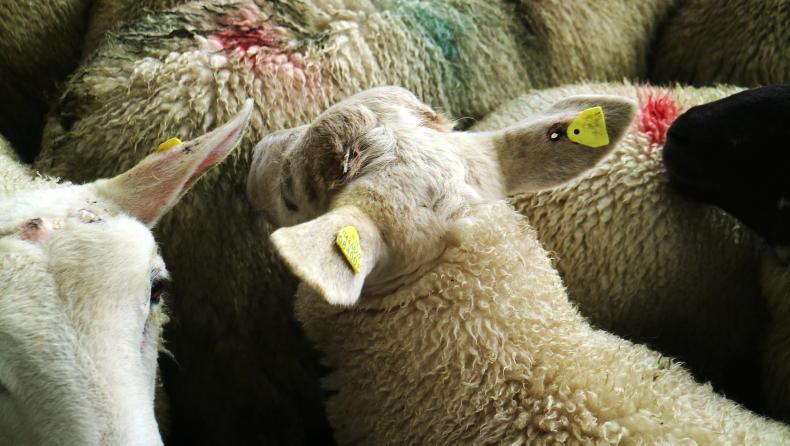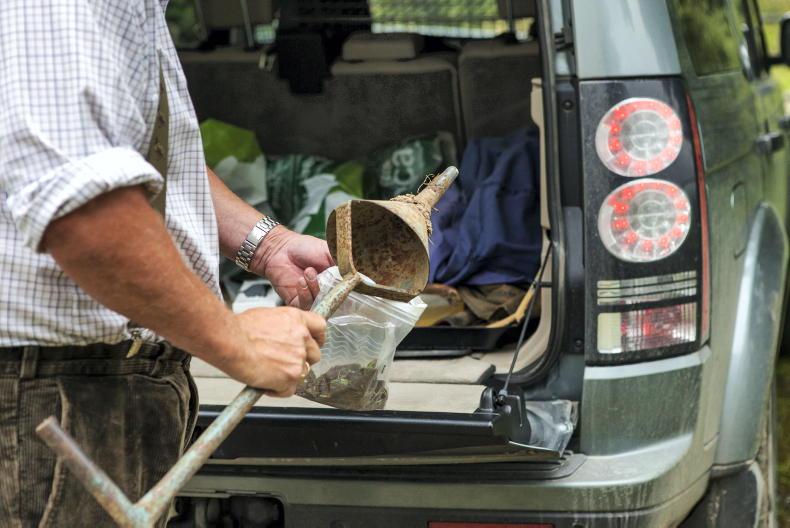An analysis of Department of Agriculture cross-compliance inspection figures for 2022 shows there were over 200 sheep tagging breaches identified in 1,297 sheep identification and registration inspections.
Within this, 70 farmers received a penalty to their direct payments with 142 farmers receiving no sanction.
The tagging breaches commonly related to sheep being tagged incorrectly with electronic tags or not possessing any tags.
There were also 164 farms where issues were identified regarding flock register maintenance, with 109 farms in this category subject to a direct payment penalty. In addition, there were 13 breaches identified by the Department involving completion of the annual sheep census with all 13 instances penalised.
Inspection process
Typically, most cross-compliance sheep inspections will have 48 hours’ notice as sheep must be penned and made available for inspection.
There are three main focal areas under the animal identification inspection process – inspection of the flock register, check on dispatch documents and an inspection of sheep to count numbers present and check for missing tags or incorrectly tagged sheep. The following is an overview of what an inspector is looking for in each section.
Flock register
An inspector will possess the records of previous sheep census applications. These will be cross-referenced with existing numbers and the flock register to ensure it is being actively maintained and kept up to date.
An inspector will also have records of tag numbers ordered from tag manufacturers and will check to see that tasks such as tagging or movements (purchases, sales, deaths) are recorded properly.
Dispatch documents
Farmers are obliged to retain dispatch document booklets and copies of dispatch documents for bought-in sheep under National Sheep Identification System (NSIS) rules for a period of three years.
Inspectors will check that movements of sheep moving on to or leaving the holding are recorded in the flock register and also that documents are being filled out satisfactorily, including notifying your local district veterinary office (DVO) of farm-to-farm movements.

A lamb which was poorly restrained when being tagged, resulting in the tag being pulled from its point of application. This will increase the risk of infection and tag losses.
The purchaser of sheep is required to send the pink copy of the dispatch document to their DVO. Rules must also be adhered to with regard to temporary movements off the farm.
Inspection
As mentioned previously, an inspector will have the results of previous census applications.
They will count the number of sheep on the holding and check that it collates with the numbers recorded in the flock register.
A sample of tag numbers will also need to be read, again to ensure that the sheep are present in the flock register.
With regard to tagging, NSIS rules state that “in general, lambs must be identified (tagged) by nine months of age (six months, if intensively reared) or on leaving the holding of origin, whichever is the earlier date. In general, sheep in Ireland are not reared intensively so nine months or on leaving the holding of origin (whichever earliest) will apply in almost all cases”.
Replacing lost tags
The move to mandatory electronic identification for sheep leaving a holding leaves only two real options to address lost tags.
Where an animal is missing a tag then a new tag with the corresponding tag number to the tag the sheep currently possesses can be ordered.
This is generally a more expensive option than the alternative as it requires more input from tag manufacturers.
Alternatively, the remaining tag can be removed and a new set of electronic identification tags (electronic and conventional tag) can be applied with the tag change recorded and correlated in the flock register.
Best practice for tagging
The manner in which tags are applied can have a big influence on retention rates.
Button tags should be applied midway in the height of the ear, taking care to avoid cartilage (which can be seen on the underside of the ear) and at a distance of about one-third of the way along the animal’s ear, measuring from the head out.
The tag should be able to rotate to leave room for air to circulate and, in sheep with thicker ears, this may need to be altered.
For wraparound tags, the advice from manufacturers includes leaving a 4mm to 5mm space between the edge of the ear and the tag for ear growth. This is to ensure tags do not become too tight as animals age.
In terms of location, the advice is to apply wraparound tags at the top of the ear and, similar to a button tag, about a third of the distance out from the head, taking care not to pierce cartilage.
Tagging should take place when animals are dry and in hygienic conditions taking care to restrain animals correctly to prevent damage to ears and larger piercings.
A tagging aid spotted at the Sheep2023 event held earlier his year in Gurteen College was a pre-tagging puncher offered by Liam Dolan, Dolan Farm Supplies, located in Brideswell, Co Roscommon. It punches an 8mm hole in the sheep’s ear and allows the ear time to heal before applying the tag.

The pre-tagging puncher cuts an 8mm hole.
Liam says feedback from farmers who were experiencing significant issues with infected ears following tagging shows that such issues can be eliminated. He adds that some farmers were also using the puncher before applying wraparound tags to allow tags to be applied easier.
The puncher retails at €32 and Liam can be contacted on 087-637 0351.
An analysis of Department of Agriculture cross-compliance inspection figures for 2022 shows there were over 200 sheep tagging breaches identified in 1,297 sheep identification and registration inspections.
Within this, 70 farmers received a penalty to their direct payments with 142 farmers receiving no sanction.
The tagging breaches commonly related to sheep being tagged incorrectly with electronic tags or not possessing any tags.
There were also 164 farms where issues were identified regarding flock register maintenance, with 109 farms in this category subject to a direct payment penalty. In addition, there were 13 breaches identified by the Department involving completion of the annual sheep census with all 13 instances penalised.
Inspection process
Typically, most cross-compliance sheep inspections will have 48 hours’ notice as sheep must be penned and made available for inspection.
There are three main focal areas under the animal identification inspection process – inspection of the flock register, check on dispatch documents and an inspection of sheep to count numbers present and check for missing tags or incorrectly tagged sheep. The following is an overview of what an inspector is looking for in each section.
Flock register
An inspector will possess the records of previous sheep census applications. These will be cross-referenced with existing numbers and the flock register to ensure it is being actively maintained and kept up to date.
An inspector will also have records of tag numbers ordered from tag manufacturers and will check to see that tasks such as tagging or movements (purchases, sales, deaths) are recorded properly.
Dispatch documents
Farmers are obliged to retain dispatch document booklets and copies of dispatch documents for bought-in sheep under National Sheep Identification System (NSIS) rules for a period of three years.
Inspectors will check that movements of sheep moving on to or leaving the holding are recorded in the flock register and also that documents are being filled out satisfactorily, including notifying your local district veterinary office (DVO) of farm-to-farm movements.

A lamb which was poorly restrained when being tagged, resulting in the tag being pulled from its point of application. This will increase the risk of infection and tag losses.
The purchaser of sheep is required to send the pink copy of the dispatch document to their DVO. Rules must also be adhered to with regard to temporary movements off the farm.
Inspection
As mentioned previously, an inspector will have the results of previous census applications.
They will count the number of sheep on the holding and check that it collates with the numbers recorded in the flock register.
A sample of tag numbers will also need to be read, again to ensure that the sheep are present in the flock register.
With regard to tagging, NSIS rules state that “in general, lambs must be identified (tagged) by nine months of age (six months, if intensively reared) or on leaving the holding of origin, whichever is the earlier date. In general, sheep in Ireland are not reared intensively so nine months or on leaving the holding of origin (whichever earliest) will apply in almost all cases”.
Replacing lost tags
The move to mandatory electronic identification for sheep leaving a holding leaves only two real options to address lost tags.
Where an animal is missing a tag then a new tag with the corresponding tag number to the tag the sheep currently possesses can be ordered.
This is generally a more expensive option than the alternative as it requires more input from tag manufacturers.
Alternatively, the remaining tag can be removed and a new set of electronic identification tags (electronic and conventional tag) can be applied with the tag change recorded and correlated in the flock register.
Best practice for tagging
The manner in which tags are applied can have a big influence on retention rates.
Button tags should be applied midway in the height of the ear, taking care to avoid cartilage (which can be seen on the underside of the ear) and at a distance of about one-third of the way along the animal’s ear, measuring from the head out.
The tag should be able to rotate to leave room for air to circulate and, in sheep with thicker ears, this may need to be altered.
For wraparound tags, the advice from manufacturers includes leaving a 4mm to 5mm space between the edge of the ear and the tag for ear growth. This is to ensure tags do not become too tight as animals age.
In terms of location, the advice is to apply wraparound tags at the top of the ear and, similar to a button tag, about a third of the distance out from the head, taking care not to pierce cartilage.
Tagging should take place when animals are dry and in hygienic conditions taking care to restrain animals correctly to prevent damage to ears and larger piercings.
A tagging aid spotted at the Sheep2023 event held earlier his year in Gurteen College was a pre-tagging puncher offered by Liam Dolan, Dolan Farm Supplies, located in Brideswell, Co Roscommon. It punches an 8mm hole in the sheep’s ear and allows the ear time to heal before applying the tag.

The pre-tagging puncher cuts an 8mm hole.
Liam says feedback from farmers who were experiencing significant issues with infected ears following tagging shows that such issues can be eliminated. He adds that some farmers were also using the puncher before applying wraparound tags to allow tags to be applied easier.
The puncher retails at €32 and Liam can be contacted on 087-637 0351.











SHARING OPTIONS